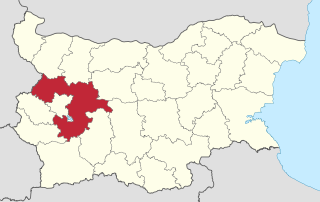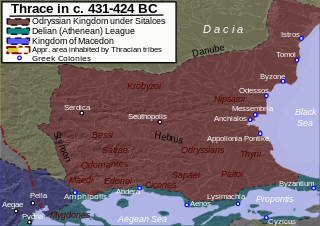
Thrace is a geographical and historical region in Southeast Europe, now split between Bulgaria, Greece and Turkey, which is bounded by the Balkan Mountains to the north, the Aegean Sea to the south and the Black Sea to the east. It comprises southeastern Bulgaria, northeastern Greece and the European part of Turkey.

Sofia is the capital and largest city of Bulgaria. The city is at the foot of Vitosha Mountain in the western part of the country. Being in the centre of the Balkan peninsula, it is midway between the Black Sea and the Adriatic Sea, and closest to the Aegean Sea.

In antiquity, Paeonia or Paionia was the land and kingdom of the Paeonians (Παίονες).

Sofia Province is a province (oblast) of Bulgaria. The province does not include Sofia in its territories, but Sofia remains its administrative center. The province borders on the provinces of Pernik, Kyustendil, Blagoevgrad, Pazardzhik, Plovdiv, Lovech, Vratsa, Montana and "Sofia-Capital", to the northwest there is border with Serbia.

The Odrysian Kingdom was a state union of over 40 Thracian tribes and 22 kingdoms that existed between the 5th century BC and the 1st century AD. It consisted mainly of present-day Bulgaria, spreading to parts of Southeastern Romania, parts of Northern Greece and parts of modern-day European Turkey.

The Bessi were an independent Thracian tribe who lived in a territory ranging from Moesia to Mount Rhodope in southern Thrace, but are often mentioned as dwelling about Haemus, the mountain range that separates Moesia from Thrace and from Mount Rhodope to the northern part of Hebrus. Herodotus described them as a sort of priestly-caste among the Satrae, the Bessi being interpreters of the prophetic utterances given by a priestess in an oracular shrine of Dionysus located on a mountain-top.
The Moesi was a Thracian tribe which inhabited present day Northern Bulgaria and Serbia, which gave its name to the Roman province of Moesia after its defeat in 29 BC. Moesia was first established as a separate province in 45–46 AD.
The history of Sofia, Bulgaria's capital and largest city, spans thousands of years from Antiquity to modern times, during which the city has been a commercial, industrial, cultural and economic centre in its region and the Balkans.
Celticisation, or Celticization, was historically the process of conquering and assimilating by the ancient Celts. Today, as the Celtic inhabited-areas significantly differ, the term still refers to making something Celtic, usually focusing around the Celtic nations and their languages.

Ratiaria was a city founded by the Moesians, a Daco-Thracian tribe, in the 4th century BC, along the river Danube. In Roman times it was named Colonia Ulpia Traiana Ratiaria.

Koynare is a town in northern Bulgaria, part of Cherven Bryag Municipality, Pleven Province. It lies on the left bank of the Iskar River, at one of the river's meanders. As of December 2009, the town has a population of 4,464 inhabitants.

The history of Thracian warfare spans from the 10th century BC up to the 1st century AD in the region defined by Ancient Greek and Latin historians as Thrace. It concerns the armed conflicts of the Thracian tribes and their kingdoms in the Balkans. Apart from conflicts between Thracians and neighboring nations and tribes, numerous wars were recorded among Thracian tribes.
Thracian clothing refers to types of clothing worn mainly by Thracians, Dacians but also by some Greeks. Its best literal descriptions are given by Herodotus and Xenophon in his Anabasis. Depictions are found in a great number of Greek vases and there are a few Persian representations as well. In contrast to shapes and patterns we have very little evidence on the colours used.
Krobyzoi is a Thracian, Getae or Dacian tribe.
Aspona was an ancient city and bishopric in Galatia, in central Asia Minor. It corresponds to the modern settlement of Sarıhüyük.











